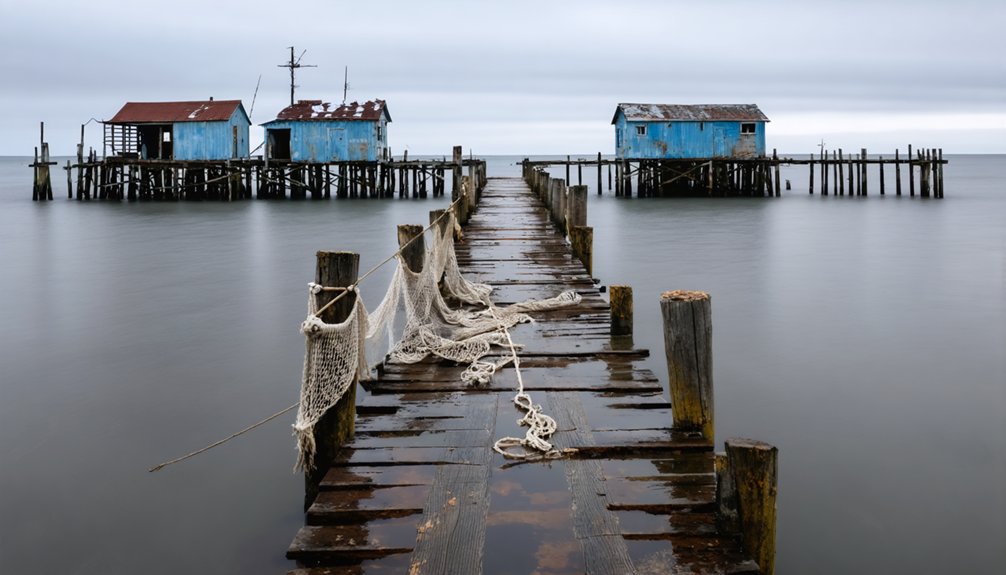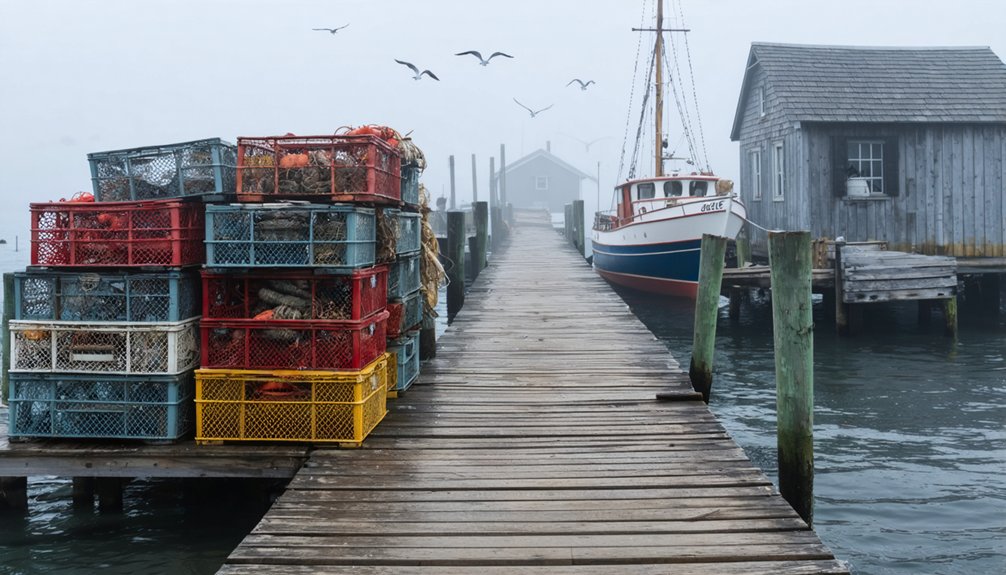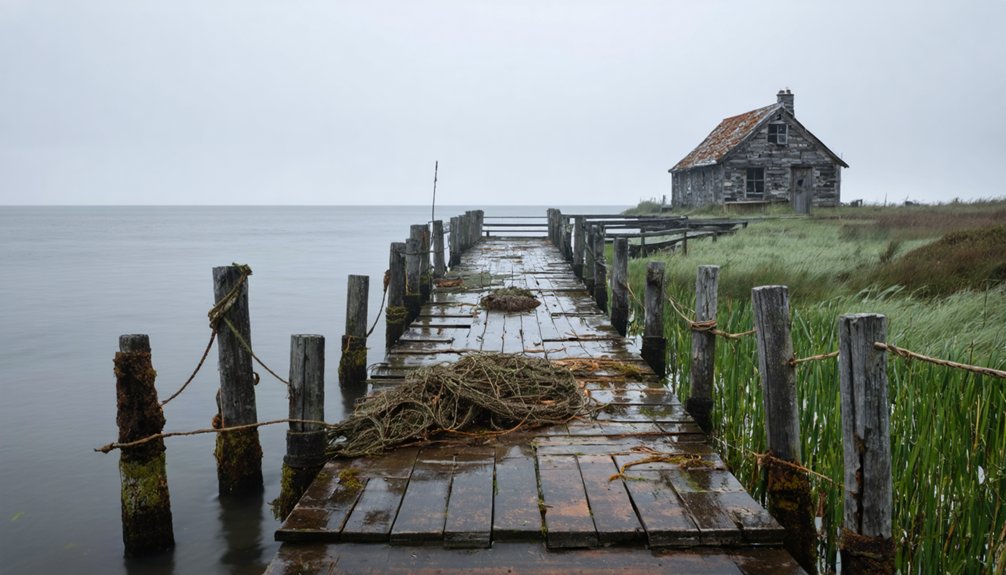Abandoned coastal fishing villages offer you hauntingly beautiful glimpses into maritime pasts. You’ll encounter weathered stone foundations, rusting processing plants, and silent harbors where nature reclaims human structures. These ghost settlements—from China’s Houtou Wan to Newfoundland’s outports—succumbed to depleted fish stocks, coastal erosion, and climate change impacts. Some communities have reinvented themselves through heritage tourism, while others stand as sobering monuments. Their crumbling facades and empty docks harbor countless stories of seafaring life.
Key Takeaways
- Abandoned fishing communities transform into haunting landscapes where crumbling structures become enveloped by verdant ecosystems.
- Coastal erosion and receding shorelines force villages into abandonment, with some areas losing 25 feet of coastline annually.
- Economic pressures from overfishing and depleted fish stocks trigger mass exodus, leaving behind silent harbors and processing plants.
- Climate change impacts like sea-level rise, saltwater intrusion, and cyclones accelerate the abandonment of coastal settlements.
- Some former fishing villages find revival through heritage tourism, documenting traditional practices, and innovative coastal restoration projects.
The Haunting Beauty of Abandoned Fishing Settlements
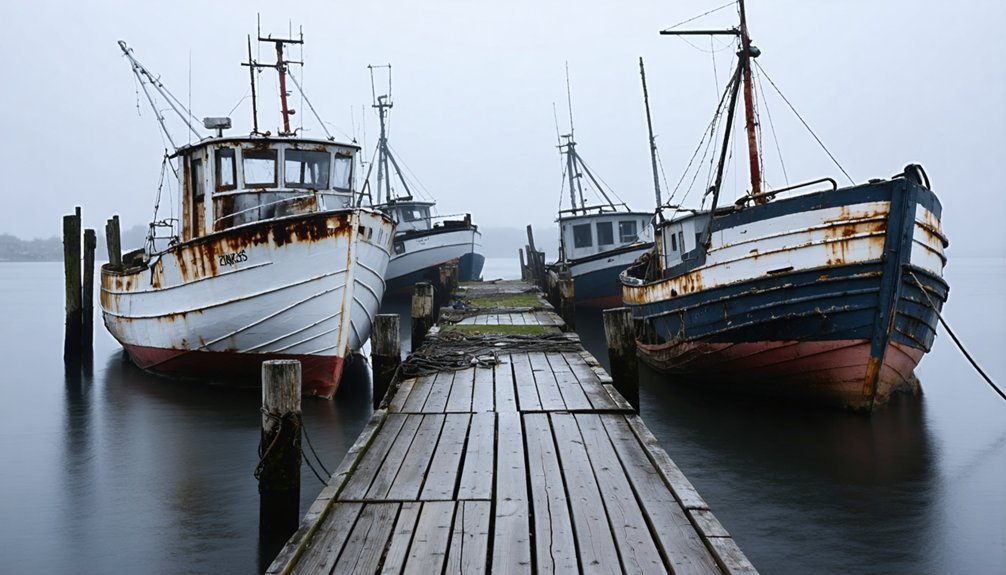
As you traverse the windswept ruins of coastal fishing settlements, you’ll encounter a world where nature steadily reclaims what humans have left behind.
Stone foundations and crumbling walls—once bustling centers of maritime commerce—now host verdant ecosystems of ivy, moss, and indigenous flora.
Where fishing fleets once gathered, nature now weaves tapestries of green life across abandoned human endeavor.
The architectural styles tell stories of bygone eras: fish-drying huts with their distinctive ventilation systems, communal docks now embraced by creeping vines, and stone cottages slowly surrendering to subtropical vegetation.
Each collapsing roof and weather-beaten doorframe carries cultural significance, marking generations of seafaring traditions.
You’ll find yourself mesmerized by nature’s reclamation project—a hauntingly beautiful transformation where birds nest in forgotten rafters and saplings emerge through fractured hearths, creating a wonderland where the pursuit of freedom from civilization is ironically fulfilled.
The striking example of Houtou Wan Village on Gouqi Island demonstrates how a once-thriving fishing community can transform into a hauntingly beautiful tourist attraction when abandoned to nature’s devices.
Many of these villages once maintained traditional methods of fish preservation, techniques nearly a century old that sustained island economies before their populations departed for modern conveniences.
How Coastal Erosion Swallowed Once-Thriving Communities
As you venture along America’s receding coastlines, you’ll witness the skeletal remains of once-vibrant fishing communities where protective beaches have vanished at rates exceeding 25 feet annually in southeastern barrier islands.
These settlements succumbed when severe storms obliterated protective dunes and natural barriers in singular catastrophic events, leaving behind uninhabitable structures that now perch precariously at water’s edge.
The economic devastation—contributing to the nation’s $500 million annual property loss—forced entire generations of maritime families to abandon ancestral homes as advancing tides transformed livable dwellings into hazardous shells destined for the sea’s claim. These communities face not only environmental challenges but also the collapse of their economies as traditional fishing practices are threatened by depleted fish stocks due to years of overfishing. This problem will likely worsen with nearly 3 billion people residing in coastal regions and projected population doubling by 2025.
Beaches Washed Away
While coastal communities once thrived along America’s shorelines, relentless erosion has rewritten their destinies with startling speed.
You’ll find staggering evidence in the Southeast’s barrier islands, where coastlines recede at 25 feet annually—and up to 50 feet yearly along the Great Lakes. These aren’t mere statistics; they represent the dissolution of coastal infrastructure that once anchored maritime livelihoods.
When you walk these ghost villages, you’re treading where seven football fields of wetlands disappear hourly.
The $500 million annual toll in property damage tells only part of the tale. Behind each abandoned fishing pier and collapsed sea wall lies a community that failed to achieve climate resilience against nature’s advancing tide.
What you’re witnessing isn’t simply ecological transformation—it’s the erasure of cultural heritage that once defined America’s relationship with her waters.
Protective Barriers Destroyed
Nature’s coastal sentinels have fallen one by one, leaving once-thriving fishing villages exposed to the sea’s relentless assault.
You’ll discover how the destruction of mangroves, wetlands, and coral reefs—which once dissipated up to 97% of wave energy—has eliminated ancient defenses that sheltered generations of maritime communities.
Without these biological fortifications, coastal restoration efforts struggle against accelerating erosion rates of 7 meters annually in unprotected areas.
The loss of these natural buffers has severely impacted the Gulf Coast region, where 64% of Texas shoreline is actively eroding.
This widespread destruction threatens 600 million people living in low-elevation coastal zones worldwide as rising sea levels compound the erosion problem.
- Skeletal remnants of mangrove forests standing like ghostly sentinels in advancing tides
- Collapsed fishing piers jutting into nowhere, their pilings undermined by ceaseless waves
- Foundation stones of homes now submerged beneath shallow coastal waters
- Tattered remnants of sea walls crumbling into the surf they once held back
- Community resilience tested by the sight of entire hamlets now claimed by the sea
Uninhabitable Shoreline Homes
The relentless advance of the sea has transformed once-vibrant coastal communities into uninhabitable ruins, leaving behind haunting evidence to mankind’s tenuous hold on shoreline settlements.
You’ll find these ghost villages throughout Arctic regions, where permafrost coastlines surrender three meters annually to hungry tides—some hotspots yielding a staggering 20 meters per year.
These uninhabitable structures stand as weathered monuments to nature’s sovereignty. By 2100, over one-fifth of Arctic coastal settlements will succumb to erosion’s march. Indigenous communities that rely on hunting and fishing economies face particularly severe displacement as their traditional lands disappear.
The economic toll is equally devastating, with projected losses reaching billions by mid-century. In the United States alone, relative sea-level rise could expose up to 1,813 km² of additional coastal land by 2050, putting billions of dollars in property value at risk. Coastal hazards compound as wetlands vanish—80,000 acres yearly in the continental United States alone.
When shoreline homes fail, communities follow; declining tax bases cripple public services, while lost fishing and tourism industries extinguish once-prosperous maritime economies.
Economic Forces Behind the Mass Exodus From Fishing Villages
Across coastal regions worldwide, economic forces have triggered a mass exodus from once-thriving fishing communities, leaving behind haunting reminders of maritime prosperity.
This economic migration stems from depleted fish stocks that have rendered generations-old fishing policies obsolete.
You’ll discover small-scale operations—often multi-generational enterprises—particularly vulnerable as overfishing claims 5.6 million livelihoods globally.
In New England alone, the collapse of cod stocks in the 1990s resulted in over 34,000 jobs lost, devastating entire coastal economies.
Places like Choshi exemplify this trend with their aging populations contributing significantly to economic challenges faced by traditional fishing communities.
- Weathered processing plants standing silent, their machinery rusting in salt air
- Empty harbors where fishing fleets once crowded against weathered docks
- Boarded storefronts of maritime supply shops that served generations of seafarers
- Abandoned family homes with nautical embellishments, weathervanes still pointing toward changing winds
- Fishing nets hanging like ghosts from forgotten poles, no longer capturing the day’s catch
Ghost Towns by the Sea: Notable Abandoned Fishing Communities Worldwide

Dotting coastlines around the world, eerily quiet settlements stand as silent witnesses to maritime history‘s ebb and flow, each with its own tale of decline.
From Hallsands in Devon, where commercial dredging led to catastrophic destruction by 1917 storms, to Houtouwan, China, where depleted fish stocks drove exodus and vegetation now engulfs buildings of cultural significance, these maritime ghosts reveal humanity’s tenuous relationship with the sea.
The North Sea’s relentless erosion has claimed dozens of medieval villages along England’s eastern shores, while remote communities like El Pardito in Mexico succumbed to isolation and harsh conditions.
Each abandoned village offers maritime archaeology treasures that tell stories of human adaptation and surrender to greater forces—both natural and industrial—preserving in their ruins the freedom once sought and ultimately relinquished by those who lived there.
The Environmental Aftermath: Pollution Legacy of Deserted Coastal Settlements
Long after inhabitants have departed, abandoned coastal fishing villages leave behind more than memories and weathered structures—they bequeath a complex legacy of environmental degradation that continues to plague marine ecosystems.
You’ll find these ghost settlements hemorrhaging marine debris—ghost nets entangling reefs, derelict fish farms releasing tonnes of waste, and weathered plastics permeating food webs. The ecosystem impact extends from microscopic to apex predators, with abandoned gear creating deadly traps for marine fauna while introducing chemical contaminants that compromise human food security.
- Ghost nets suspended like spectral curtains among once-vibrant coral reefs
- Rusting cage structures jutting from seafloors like skeletal remains
- Microplastics swirling in tidal pools where children once played
- Entangled sea turtles struggling against abandoned monofilament
- Fishermen’s weathered boats becoming artificial reefs of unintentional consequence
Weather and Climate: Nature’s Role in Village Abandonment
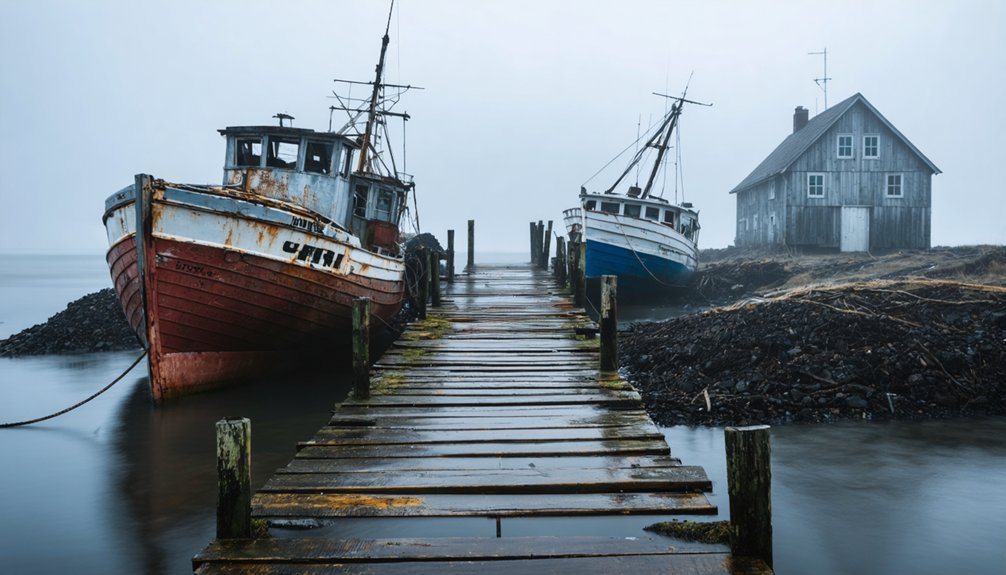
While historic accounts often attribute village abandonment to economic factors or social shifts, the relentless forces of climate change have emerged as the primary architect of coastal settlement dissolution in recent decades.
As you explore these ghost villages, you’ll witness the stark reality of accelerating sea-level rise claiming up to 66.75% of island landmasses since 1850.
Weather patterns have transformed dramatically—cyclones regularly devastate homes while high tidal surges undermine building foundations. Climate impacts manifest in widespread saltwater intrusion, rendering farmland barren and killing once-thriving forests.
Predictions suggest complete abandonment between 2030-2065 as uplands convert to wetlands at alarming rates. Former beacons and structures built safely inland now teeter over cliff edges—silent sentinels to nature’s advancing claim on human enterprise.
Lost Maritime Heritage: Preserving Fishing Traditions Before They Disappear
In coastal communities facing abandonment, you’ll witness the urgent need to document traditional fishing methods before they’re lost to time—from complex trap designs to seasonal harvesting techniques that once sustained generations.
You’re encountering a critical juncture where oral histories from elders represent irreplaceable repositories of maritime knowledge, containing detailed accounts of navigation techniques, weather prediction, and sustainable fishing practices developed over centuries.
Your attention to the vanishing skills crisis is warranted, as specialized abilities like net-making, traditional boat construction, and indigenous preservation techniques fade with each passing year, taking with them practical solutions to environmental challenges modern fishers now confront.
Documenting Traditional Fishing Methods
As traditional fishing methods vanish at an alarming rate across abandoned coastal communities, maritime historians and ethnographers race to document these irreplaceable practices before they’re lost forever.
The cultural significance of techniques like bowfishing—once practiced by Philippine Negritos targeting Giant Trevally—represents ecological wisdom developed over centuries.
- Barefoot tramping in Southwest Scotland, where fishers detected flounder by feel before capturing them with three-pronged leisters
- Intricate fishing kites crafted from banana leaves and spiderweb lines to attract surface-feeding needlefish
- Community-managed Corrales de Pesca in Chile, where familial ownership blends with communal access rights
- Pulse fishing systems that rotate fishing grounds seasonally, allowing stocks to recover naturally
- Hand-selection methods using specific hook sizes and bait types that minimize bycatch while preserving marine nurseries
These traditional techniques embody freedom—sustainable harvesting without corporate oversight or technological dependencies.
Oral Histories Matter
The three pillars of maritime heritage—artifacts, structures, and oral histories—stand as sentinels against cultural amnesia, yet oral traditions remain the most vulnerable to permanent erasure.
When you collect fishermen’s narratives, you’re preserving intangible cultural heritage that scientific data can’t capture. These oral traditions document ecological knowledge, community-based conservation practices, and intergenerational wisdom about the sea.
You’ll find that abandoned villages still speak through their former inhabitants, offering contextual understanding of maritime landscapes and reinforcing cultural identity despite depopulation.
As elders pass without recording their memories, traditional ecological knowledge vanishes forever. Through ethnographic interviews and multimedia documentation, you can safeguard these narratives from oblivion.
Cultural preservation isn’t merely academic—it’s the lifeblood of collaborative governance between communities and conservation authorities, ensuring maritime heritage remains vibrant even as villages fade into history.
Vanishing Skills Crisis
Alongside vanishing oral traditions exists an equally alarming phenomenon: the rapid disappearance of specialized maritime skills that once defined coastal fishing communities.
As traditional fishing grounds collapse and young seafarers abandon their heritage for more stable livelihoods, generations of accumulated nautical expertise face extinction. The knowledge transfer systems that preserved these capabilities through mentorship are breaking down, leaving irreplaceable skills preservation challenges.
- Hand-knotting intricate nets capable of selectively harvesting specific species
- Steering through treacherous coastal passages using only celestial positioning and landmark recognition
- Interpreting subtle ocean conditions to predict fish movements and weather changes
- Constructing and maintaining wooden vessels using traditional joinery techniques
- Reading seasonal ecological patterns to anticipate spawning cycles and migration timing
Without deliberate intervention, these maritime competencies will vanish into history’s depths.
Revival Stories: Breathing New Life Into Forgotten Coastal Communities
Forgotten by the tides of progress, countless coastal fishing villages have weathered economic collapse as traditional maritime industries declined. Yet remarkable revival stories demonstrate how communities can chart new courses toward sustainability.
You’ll find Conche, Newfoundland exemplifies this renaissance, transforming from cod-dependent outport to vibrant destination through community storytelling and heritage tourism. Their museums preserve maritime knowledge while distinctive accommodations replicate historical structures, drawing cultural voyagers to their shores.
Elsewhere, Java’s coastal hamlets combat abandonment through mangrove restoration, reclaiming 200 meters of shoreline.
Meanwhile, Northern Yucatan villages blend traditional palapa construction with modern techniques. Even ruins like Hallsands have found purpose as archaeological sites documenting environmental change, with viewing platforms supporting educational tourism while preserving their somber testimony to nature’s power.
Documenting Disappearance: Photography and Film of Vanishing Fishing Villages
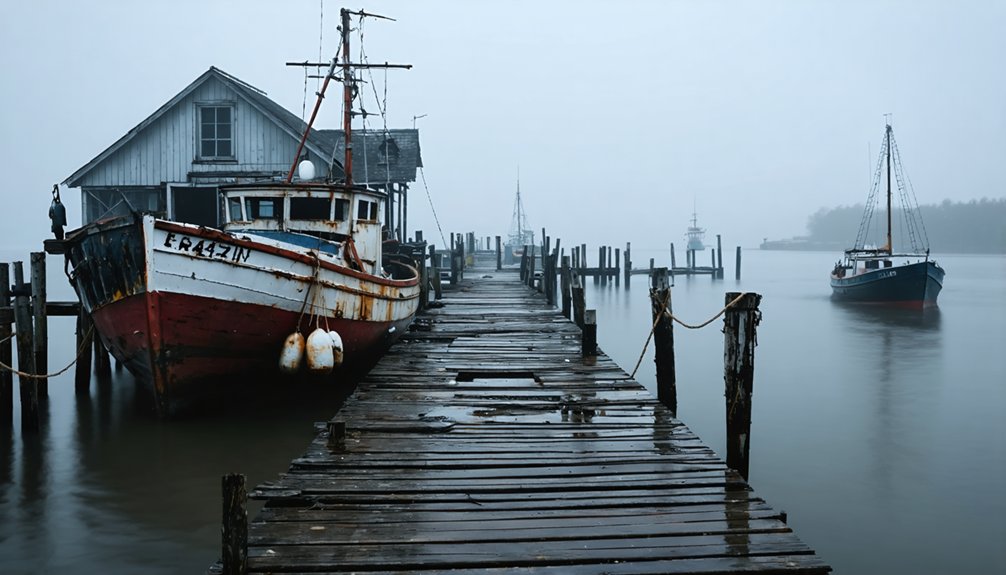
As maritime communities slip beneath the waves of economic change and environmental pressures, photographers and filmmakers have emerged as essential chroniclers of coastal fishing villages‘ twilight hours.
From Charles Farrell’s 1930s North Carolina portraits to contemporary expeditions in abandoned archipelagos, these visual records preserve cultural narratives of vanishing ways of life.
Through the lens of time, images become elegies for maritime cultures ebbing with each passing tide.
You’ll find the historical significance of these works in their capacity to bear witness to shifts that might otherwise go unnoticed, capturing not just physical structures but the social fabric of communities in flux.
- Salt-weathered shacks leaning against gathering storm clouds
- Elderly hands mending nets in dying light of fish-house windows
- Empty docks with ghostly mooring lines swaying in the tide
- Sun-bleached boat hulls sinking into marshy shorelines
- Overgrown pathways where generations once carried their daily catch
Sustainable Futures: Learning From the Past to Protect Remaining Coastal Communities
While abandoned coastal villages stand as stark reminders of what’s been lost, their lessons now inform resilience strategies for surviving maritime communities.
You’ll find today’s coastal planners integrating ecosystem services—wetlands, dunes, reefs—into development frameworks, recognizing how these natural buffers protected ancestral fishing hamlets for generations. These sustainable practices draw from traditional knowledge while incorporating modern Integrated Coastal Zone Management principles.
Community resilience now hinges on balancing economic necessities with ecological preservation. The most successful approaches democratize decision-making, elevating local and Indigenous voices, particularly women’s leadership in fisheries governance.
Frequently Asked Questions
Can Abandoned Fishing Villages Be Legally Claimed by New Inhabitants?
No, you can’t legally claim abandoned villages. Property rights remain with original owners, though squatter laws might apply in certain jurisdictions. You’d navigate complex maritime regulations to establish legitimate occupancy.
What Artifacts Are Typically Left Behind in Deserted Fishing Villages?
While you might expect treasures, you’ll mostly find mundane remnants: weathered boats rotting at broken docks, tattered fishing nets, domestic ceramics, shell middens, and crumbling stone structures marking where life once thrived.
Do Indigenous Rights Apply to Abandoned Traditional Fishing Settlements?
Yes, indigenous rights persist. Your sovereignty remains tethered to these maritime sanctuaries through traditional knowledge systems, regardless of habitation status. International law recognizes your enduring connection to ancestral waters and coastal domains.
Are Underwater Archaeological Remains Found Near Abandoned Coastal Villages?
Profound prehistoric presence persists beneath the waves. You’ll find shipwrecks, submerged settlements, and ceremonial structures of archaeological significance near these villages. These underwater discoveries reveal maritime heritage your ancestors left behind.
How Do Local Supernatural Beliefs Affect Abandoned Fishing Village Preservation?
You’ll find supernatural lore anchors preservation efforts through taboos that restrict resource exploitation, maintaining sacred sites as biocultural havens while village elders’ rituals sustain connections between ancestral spirits and abandoned maritime landscapes.
References
- https://maritimearchaeologytrust.org/3407-2/
- https://traveltalesoflife.com/el-pardito-fishing-village-baja-mexico/
- https://en.wikipedia.org/wiki/List_of_ghost_towns_by_country
- https://www.weforum.org/stories/2024/07/abandoned-fish-farms-greece-ocean-pollution/
- https://www.youtube.com/watch?v=x2ql_djMzJQ
- https://www.icrc.org/en/document/berdyanske-war-ravages-fishermans-legacy
- https://mymodernmet.com/zhoushan-gouqi-island-hou-tou-wan-abandoned-fishing-village/
- https://www.buubble.com/explore-selatangar-the-historicаl-ruins-of-аn-old-fishing-station-in-iceland/
- https://www.insidehook.com/culture/inside-a-fishing-village-overrun-by-foliage
- https://www.youtube.com/watch?v=q80hUQkDdbI
